
Pork Menu: 1 2 3 4 5 Next>>
Pork As Food During the Golden Age of Piracy, Page 2
Eating Pork
We've seen that pork was regular part of the British Royal Naval sailor's diet. It was also featured in the officer's meals and at shipboard feasts, hinting at its desirability as a foodstuff.
Despite the alleged multi-year durability of salt pork mentioned previously, there were many complaints about bad pork in period accounts. The meat was incredibly salty, leading some to suggest it led to diseases like scurvy. Pork often goes bad before other meats, particularly in hot climates.
Although it was a popular part of late 17th and early 18th century diets, not everyone was in favor of pork as a part of people's regular diet; some period writers expressed concerns about its suitability as a food. These accounts advised people on how to produce more healthy pork.
Eating Pork: Feeding the Men Before the Mast
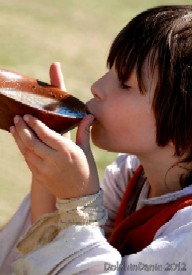
Photo: Dolphin Danni
Reeanactor Zach Shows How He
Eats Period Soup
It is believed that the diet in the British Royal Navy was fairly constant throughout the golden age of piracy. Using comparative stable isotope analysis of the collagen found in bones of sailors buried at the Royal Naval Hospital burial grounds at Plymouth and Gosport as well data from bones recovered from the Mary Rose, researchers have established that the "naval diet was virtually unchanged from the 16th century through the end of the 18th century."1 Their analysis showed that sailor's diets were consistent with the period records and included "flour, oatmeal, suet, cheese, dried pork, beer, salted cod, and ships biscuits when at sea."2 The reference to "dried pork" refers to salted pork as was discussed on the previous page.
According to the Purser's Instructions, which were issued to ship's purser's during the 18th century (possibly as early as 1735), on Sundays and Thursdays each sailor was to have "pound pork, ½ pint peas" in addition to "a pound of biscuit and a gallon of beer daily."3 The HMS Richmond website lists a recipe for these elements (which unfortunately doesn't list the original source, so we cannot be sure that it is a period recipe, although it seems like something an armed service might dream up for its men and then use repeatedly for centuries.):
Peas and Salt Pork
1 lb. Salt Pork
½ pt. Dried Peas
¾ quarts Water
Soak the pork and peas separately in cold water overnight. Cut the pork into bite-size pieces and place in a pot with the peas, along with ¾ quarts of water. Bring to a boil then reduce heat and simmer until peas have turned to mush. Salt and pepper to taste.4
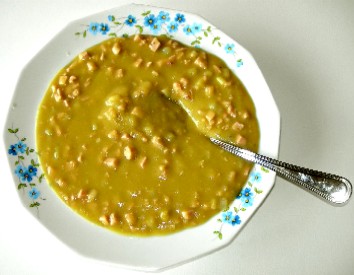
Photo: Wiki User Erbsensuppe
Pea Soup With Pork - Just Like the Mom (and the
British Royal Navy)
Used to Make?
Of course, what the Royal Navy ate was not necessarily what merchant ships ate, and almost certainly not what pirates usually ate. One merchant ship sailor, Francis Rogers, explained in a 1702 entry in his journal that dolphin meat could be made into a meal by boiling it "with a piece of pork and oatmeal or rice"5.
Although her cookbook came out about two decades after the end of the golden age of pirates, Hannah Glasse (b. 1708) provides a whole chapter of recipes entitled 'For Captains of Ships'. Although this book was first printed in 1747, these recipes may still be close to accurate for the time. Reenactor and researcher Jen Dobyns points out that, "Period cookery books tend to be published at the end of the author's career, so there is an accumulated collection of receipts over the course of that person's career spanning back decades."6 Still, Glasse would have been about 17 and the very end of this golden age of pirates, as defined on this website (1690-1725).
However, it is not entirely clear whether these recipes were for the men, the officers of a ship, or both. Among the foods Glasse suggested, three contain salt pork. The first is for pea soup, which sounds much like the recipe above with a few additions to make the flavor a bit more complex.
To make pease-soop.
GET a quart of pease, boil them in two gallons of water till they are tender, then have ready a piece of salt pork or beef, which has been laid in water the night before; put it into the pot. with two large onions peeled, a bundle of sweet-herbs, celery, if you have it, half a quarter of an ounce of whole pepper; let it boil till the meat is enough, then take it up, and if the soop is not enough let it boil till the soop is good; then strain it, set it on again to boil, and rub in a good deal of dry mint. Keep the meat hot; when the soop is ready, put in the meat again for a few minutes and let it boil, then serve it away.7
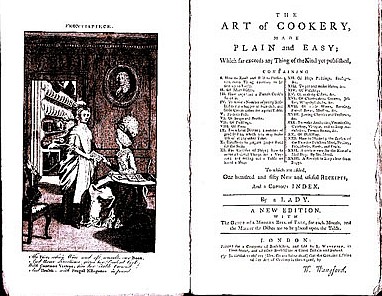
The Art of Cookery Frontispiece and Title Page (1770 Edition)
Glasse also provides a receipt for pork-pudding, which seems like an less likely candidate for every day dining.
To make pork-pudding, or beef, &c.
MAKE a good crust with the dripping[s of the meat], or mutton suet, if you have it, shred fine; make a thick crust, take a piece of salt pork or beef,which has been twenty-four hours in soft water; season it with a little pepper, put it into this crust, roll it up close, tie it in a cloth, and boil it; if for about four or five pounds, boil it five hours.8
Finally, she gives instructions for the captain to cook (or, more likely, arrange to have cooked) Cheshire pork-pie. This again sounds a bit fancy for daily fare.
To make a Cheshire pork-pie.
TAKE some salt pork that has been boiled, cut it into thin slices. an equal quantity of potatoes pared and sliced thin, make a good crust, cover the dish, lay a layer of meat,.seasoned with a little pepper, and a layer of potatoes; then a layer of meat, a layer of potatoes, and so on till your pie is full. Season it with pepper; When it is full, lay some butter on the top, and fill your dish above half full of soft water. Close your pie up, and bake it in a gentle oven.9
One can but hope there is a gentle oven on the ship!
It is notable that all the recipes call for soaking the meat for several hours in advance. This was done to remove as much of the salt as possible.
1 Patrick Roberts, Sam Weston, Bastien Wild, Ceridwen Boston, Peter Ditchfield, Andrew J. Shorthand & A. Mark Pollard, "The men of Nelson's navy: A compartive stable isotope dietary study of late 18th century and early 19th century servicemenfrom Royal Naval Hospital burial grounds and Plymouth and Gosport, England", American Jounral of Physical Anthropology, p. 1, May 2012; 2 Archaeologists Reconstruct Diet of Nelson's Navy with new Chemical Analysis of Excavated Bones, wiley.com, gathered 4/7/14; 3 Meryl Rutz, Sea Horse and Ship's Biscuit, navyandmarine.cor, gathered 4/7/14; 4 Diet and Recipes, HMSRichmond.org, gathered 4/8/14; 5 Francis Rogers. from Bruce S. Ingram's book Three Sea Journals of stuart times, 1936, p. 151; 6 Jen Dobyns, 18th Century Recipes, Pyracy.com Forum, gathered 4/11/14; 7 Hannah Glasse, The art of cookery, made plain and easy, 1774 Edition, p. 243-4; 8 Glasse, p. 244; 9 Glasse, p. 247;
Eating Pork: Feasting Shipboard
Pork often appeared as a part of feasts and officers meals in sea literature from this time, hinting at its desirability as a meal shipboard. Despite being on short rations in 1681, Captain Bartholomew Sharp recorded that on Christmas-Day, "to Solemnize that Festival as well as we could, we eat the only Hog we had left, drank some Jars of Wine, and made our selves as merry as we were able, which I did that my Men might not mutiny."1 Although it is not so much a celebration as observance of a belief, while in Santo Domingo, Dominican Republic, Père Jean-Baptiste Labat explained that he had purchased "1,800 pounds of smoked
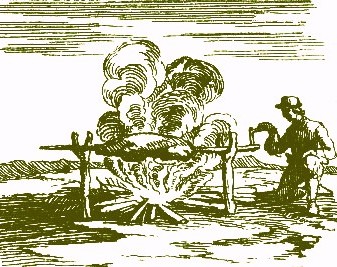
A Conchon Boucain, from On the Spanish Main,
by John Masefield, p. 114 (1906)
meat, and 300 pounds of mantegne, or pig’s fat. This mantegne is eaten by the Spanish during Lent in virtue of the Pope’s bull of the Crusade"2
Labat is the source of perhaps the most extensive account of a pig at the center of a celebration. His description of a buccaneer-style 'cochon boucan' (literally 'pig barbecue' in French) is very entertaining and lavishly detailed. Labat explains, "On these occasions everyone must pretend to be buccaneers, who cook their pig and amuse themselves in much the same way when they wish to take a holiday."3
Labat seems to have been a jolly fellow, who enjoyed food very much. Since this account has already appeared in full on this web page in the Christmas Holidays at Sea in the Golden Age of Piracy article, I will not repeat it here. It is a fascinating narrative, however, and I recommend checking out the linked page for a full appreciation of how pork wound up at the center of at least that type of holiday.
Labat also provides us with a tale of a meal on a Spanish ship which included pork. Because he was a priest as well as a guest of the captain, Labat ate with the officers, providing some insight into how the Spanish officers supped.
The first course was five dishes of fruit and the chaplain first served the Governor, and then the rest of the company. After the fruit had been removed, a large dish of sausages and tripe was served. This surprised me as it was Holy Saturday, but the chaplain observing this told me that at sea one did the best one could, and further that the Pope’s bull of the Crusade allowed privileges which I might also enjoy since I was their guest. Naturally I did my best to oblige my hosts and ate everything with a hearty appetite. The sausages were followed by three large boiled chickens, and these by a ragout [stew] of pork. After this we ate a dish of pigeons, then a great bowl of potato broth, and to finish we had chocolate.4
Fellow clergyman Henry Teonge was similarly enamored of the meals fed to the officers during his two British Royal Naval voyages, one aboard the Assistance in 1675-6 and the other aboard the ships Bristol and Royal Oak in 1678. Teonge explained that on July 10th, 1675, the "Captain feasted the officers of his small squadron with four dishes of meat, viz. four excellent hens and a piece of pork boiled in a dish;
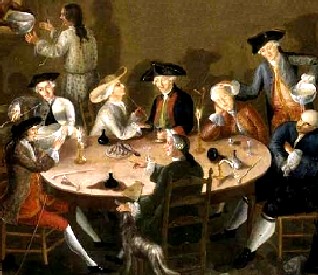
Artist: John Greenwood
Sea Captains Carousing in Surinam (1750s)
a gigget [leg] of excellent mutton and turnips; a piece of beef of eight ribs, well seasoned and roasted; and a couple of very fat green geese; last of all a great Cheshire cheese: a rare feast at shore."5 Eighteen days later he said, "we strain our shrouds [rigging holding the masts up on the sides - they were moving fast]; and our Captain feasts the Unity and Scipio with good pork, beef, geese, ducks, hens, chickens"6.
Both of these meals were feasts designed to entertain officers from other ships. The wide variety of meats is notable, although not really all that surprising given the popularity of meat in the sailor's diet. Teonge doesn't share the menu for every day of his journey, apparently only including it when the meal was significant to him.
Pork is included in at least three other entries in his diary. On February 4, 1676, he boasts of a pork-intense meal which included "a gallant baked pudding, and excellent leg of pork [possibly referring to a ham] and cauliflowers, an excellent dish made of pigs’ pettitoes [feet], two roasted pigs, one turkey cock, a roasted hog’s head, three ducks, a dish of Cyprus birds, and pistachios and dates together, and store of good wines."7
Roasted hog's head seems an unusual recipe, although it appears in several cookbooks from around this time. In her 1734 book of '300 receipts' Mary Kettilby gives a recipe 'To make excellent Meat of a Hog's Head':
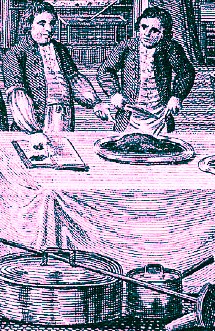
Following a Recipe, From The
Housekeeper's Instructor, by William
Augustus Henderson, Frontispiece (1791)
Take the Head and split it, take out the Brains, cut off the Ears, and lay it in Water one Day, then boil it 'till all the Bones come out, then take off the Skin as whole as you can, for that is to be laid over and under it: chop it small, as fast as you can, while it is hot; season it with Pepper, Salt, Mace, Nutmeg, or Jamaica Pepper, if you like it, instead of Mace; press it down into a Pudding, or Venison-pan, lay the Skin over and under it, cover and press it down very close, and when 'tis quite cold 'twill turn out, and cut as close as a Cheese; you may add Salt and Vinegar to some of the Liquor 'twas boil'd in, and keep it in that Pickle: 'Tis eat with Vinegar or Mustard, and is better than Brawn [head cheese - made from the flesh of the head of a pig or cow], if the Head you make it of be large and fat.8
On Teonge's second journey, he does not mention the meals as often. On November 13, 1678, he talked of a meal of "an aitchbone [hipbone] of good beef and cabbage; a hinder-quarter of mutton and turnips; a hog’s head and haslett (Endnote 57: Haslett or haralett; a pig’s chitterlings [intestines]) roasted; three tarts, three plates of apples, two sorts of excellent cheese: this is our short-commons [meager rations] at sea."9 (Clearly he was being facetious.) On April 14 of the next year, he explained that they "had a pig to dinner this day worth 8s. in England."10 While the menu was not quite as wondrous as his first journey, it was clearly still a cut above what the men were eating.
1 Bartholomew Sharp, "Captain Sharp's Journal of His Expedition," from William Hacke's A collection of original voyages, p. 54; 2 Pere Jean-Baptiste Labat, The Memoirs of Pére Labat 1693-1705, p. 174-5; 3 Labat, p. 52; 4 Labat, p. 187-8; 5 Henry Teonge, The Diary of Henry Teonge, Chaplain on Board H.M.’s Ships Assistance, Bristol, and Royal Oak, 1675-1679, p. 44; 6 Teonge, p. 55; 7 Teonge, p. 126; 8 Mary Kettilby, A collection of above 300 receipts in Cookery, Physick, and Surgery, 1734 edition, p. 206-7; 9 Teonge, p. 228; 10 Teonge, p. 251

